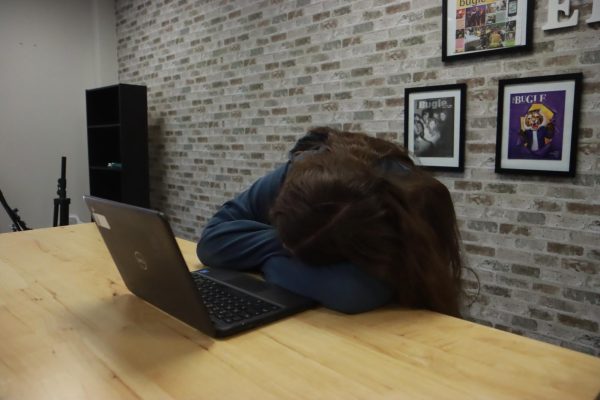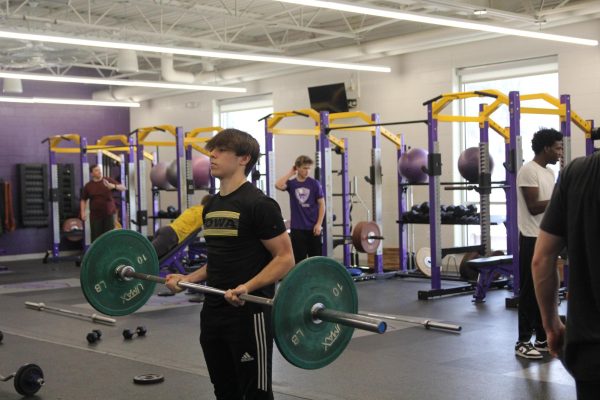Back to the brown bag
A new school year brings opposition to changes in policy
All commercial food, including Bread Company, cannot be delivered during the school day, October 2016.
Dual enrollment students walking through the doors of the Welcome Center with a “Jimmy John’s” bags in hand are greeted by an adult working the check-in desk at the front entrance and a, “You can’t bring that in here.”
They protest, “We can’t bring our lunch in?”
“I don’t make the rules,” she replies. “I just enforce them.”
In the trash goes a couple of #1 Pepe subs and $12.
Head Principal Charles Crouther mandated that students could not receive commercially prepared food at school, October 2016.
“The school lunch is a lot cheaper than ordering food, but sometimes it’s not always the best,” Zach Reed (11) said. “But if it’s against the rules, it’s against the rules. What are you going to do about it?”
Often referred to as the food-delivery ban, the rule can seem cruel in this age of food delivery and accessibility.
“Ban isn’t really the word I think we should use,” Crouther said. “We just changed our procedure and policy so that no commercially prepared food can be ordered or come in through the front door during the lunch period.”
Crouther, concerned about safety and accessibility, decided that the luxury of food delivery was not worth the confusion those deliveries created on campus.
“I was the instigator, ringleader, the one who brought it to the surface because something had to be done about it,” Crouther said. “I didn’t do it maliciously. I just wanted this school to be safe and not disrupted at the front of the building.”
Area restaurants have been notified to not deliver, and the administration hopes that parents understand restricted access to the building helps maintain student safety.
One delivery requires time and manpower of which student and parent are unaware. Multiple deliveries becomes can overwhelm a previously-functioning system.
“The parents expect that we will contact the student and notify them with phone calls or notes,” Audrey Bell, hall monitor, said. “We have to get a hold of them to let them know it’s there.”
Since students are not supposed to be using their cell phones during instructional time and reception is poor throughout the majority of campus, texting between student and parent is a problem since it doesn’t involve school personnel.
“I think if parents are bringing lunchboxes or food for their kids that should be allowed,” Caroline Kneedler (12) said.
Crouther points to heavy traffic in front of the Welcome Center, a concern when trying to keep campus locked down.
“It is literally causing a traffic jam in front of the school,” Crouther said. “It is allowing a lot of traffic going from the cafeteria area down to the Welcome Center. We aren’t prepared thatㅡsecurity wise.”
Anyone can dress up as a delivery person or walk onto campus like they belong there. Cedric Anderson walked through the front door of North Park Elementary School and opened fire on his wife and her special ed students, April 2017. Anyone can seem innocent.
Worst-case scenarios aside, parent to student communication can seem simple to the two involved but can create confusion for school personnel.
“Of course, there are cell phone issues involved,” Bell said. “It just becomes a problem and a burden when you’re really supposed to be here for instructional time.”
The classroom teacher is on the frontline of this issue. Trying to get 20 individuals focused on the same thing and doing the same thing at the same time.
Those communications with home affect more than the two people involved in them.
“Cell phones are probably the biggest source of distraction with the notifications we constantly get on our phones,” Symphony Bruce, Language Arts, said. “Phone calls are a big distraction. That noise startles everybody and depending on how long that phone call is, it provides quite the opportunity for conversation. But if somebody is coming in to grab a student, I find it to be pretty easy to get back on track.”
While everyone needs to eat, the purpose of school is to learn.
“We are a community of people trying to learn in the same environment, and we don’t all learn in the same way. We don’t interact in the same way,” Bruce said. “We want different things out of our teachers and out of our classmates and because of that we are in an environment that is going to be distracting no matter what.”
With this mandate, Crouther is trying to eliminate distractions in the classroom.
Last October, Crouther sent out a pre-recorded voice message and email alert to parents explaining the change in procedure. However, how that information has reached students is unclear. Principals referenced the fact during class meetings, Aug.17.
The change is restrictive but not meant to be punishing.
Kneedler described one experience.
“One day, I was very sick and I forgot lunch and I didn’t have money in my account. So my dad agreed to bring me Bread Co. for lunch. He brought in the food and he wasn’t allowed to give it to me,” Kneedler said. “I had to eat it in the lobby with him and he was just like sitting on the couch like, ‘Okay this is kind of ridiculous. It’s kind of an overkill.’”
Crouther notes there are extenuating circumstances and school personnel are committed to the students.
“In that we’d have to say, ‘No problem, let’s get that soup and bring it on down here to the nurse’s office’ because it’s involving an illness,” Crouther said. “Or I would bring it over to the counseling department’s conference room. But it’s not going to get past the main office… Yes, there are extenuating circumstances where we have to step back for a minute, analyze that and proceed in the right direction. It’s in the best interest of the students.”
Communication may be the key to avoiding student and parent frustrations. Beyond the email and call home last October, the only word out to the community has been a mention in class meetings.
“I think it’s kind of frustrating when my parents can’t drop off my lunch if I forgot it or can’t bring me food from a different place just because it has the Jimmy John’s logo on it or something like that,” Ellie DuBroc (12) said. “I just think it’s kind of stupid.”
Parents can drop off items before 10:30 a.m., and a little creative thinking may bypass the issue.
“If you brought that in leftover form in a brown paper bag or, even better than that, if you rewrapped it in some type of cellophane, we’ll never know,” Crouther said. “That’s not what we’re looking for. We’re trying to solve the confusion at the front door.”
So next time food is rejected at the front door, remember that adult didn’t make the rule. She is just doing what is asked of her by her boss. She is just doing her job.
“As far as I’m concerned, I didn’t have any issue with it,” Laura Bradford, Welcome Center receptionist, said. “It came from above me, and I’m just going to leave it at that.”
Perhaps time spent on getting the word out would eliminate much time spent on enforcing the rule. In the meantime, note to self: No commercial food deliveries at school.
“We are a closed-campus lunch,” Crouther said. “We eat here what we provide here.”
Your donation will support the student journalists of Eureka High School - MO. Your contribution will allow us to purchase equipment and cover our annual website hosting costs.

This is Kate’s first semester on the EHS hub staff. She is a news reporter and also covers sports. You can follow her on twitter @klaubEHS_Hub.
Kate’s...




















